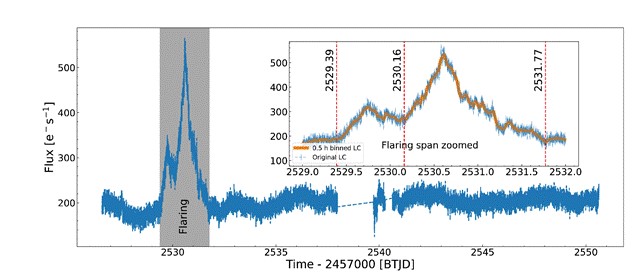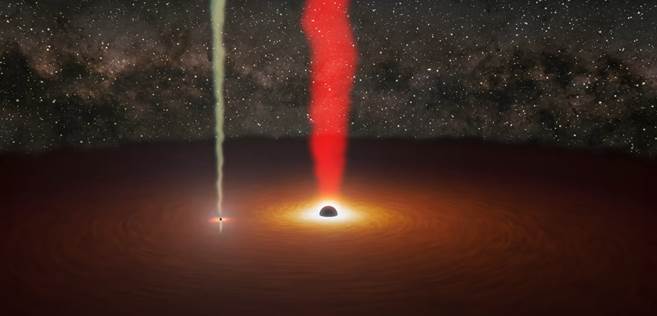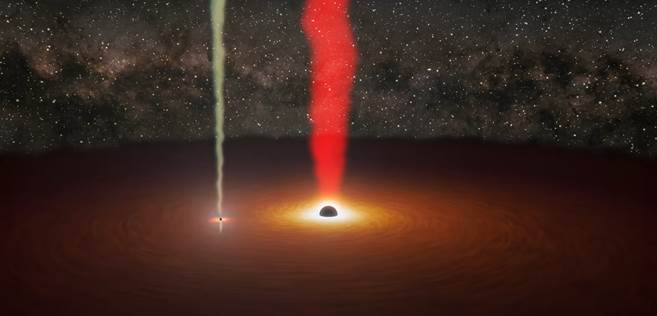Scientists Spot Orbiting Black Hole in Distant Galaxy
A new study by 32 scientists from 10 countries (Finland, Poland, India, China, USA, Czech Republic, Japan, Germany, Spain, Italy) has confirmed the sighting of a smaller black hole orbiting a larger one, establishing the first visual evidence of an orbiting black hole.
Several international research groups had already confirmed the theory that there are two black holes at the center of the four billion light-years distant galaxy OJ 287, first suggested by astronomers at the University of Turku, Finland.
In 2021, NASA's exoplanet-hunting satellite, TESS (Transiting Exoplanet Survey Satellite), was pointed towards the galaxy OJ 287 to help confirm the theory initially proposed by researchers at the University of Turku. TESS, designed to discover exoplanets orbiting the brightest dwarf stars, has so far found 410 confirmed exoplanets.
In 2021, TESS spent several weeks studying the OJ 287 galaxy. Researchers found indirect evidence that a very massive black hole in OJ 287 is orbiting a giant black hole 100 times its size.
To verify the existence of the smaller black hole, TESS monitored the brightness of the primary black hole and the jet associated with it. Although direct observation of the smaller black hole is challenging, its presence was revealed by a sudden burst of brightness.
This event had never been observed in OJ 287 before, but researcher Pauli Pihajoki from the University of Turku predicted the event in his doctoral dissertation in 2014. According to his dissertation, the next flare was expected in late 2021, and several satellites and telescopes were focused on the object at the time.
The TESS satellite detected the expected flare on November 12, 2021, and the observations of the 12-hour event were recently published in the Astrophysical Journal Letters.
The study of the observation by Shubham Kishore and Alok C. Gupta from the Aryabhatta Research Institute of Observational Sciences, and Paul Wiita from The College of New Jersey, USA, confirmed the existence of a smaller black hole.
The discovery was also confirmed by NASA's Swift telescope, which was pointed at the same target. Additionally, a large international collaboration led by Staszek Zola from Jagiellonian University in Poland detected the same event using telescopes in different parts of the Earth to ensure continuous observation.
A group from Boston University, USA, led by Svetlana Jorstad and other observers, confirmed the discovery by studying the polarization of light before and after the flare.
In a new study combining all previous observations, Professor Mauri Valtonen and his research team at the University of Turku have shown that the 12-hour burst of light came from the smaller black hole in orbit. This burst occurs when the smaller black hole swallows a large slice of the accretion disk surrounding the larger black hole, turning it into an outward jet of gas. This makes the jet of the smaller black hole brighter than that of the larger black hole for about twelve hours.
“Therefore, we can now say that we have ‘seen’ an orbiting black hole in the same way that we can say that TESS has seen planets orbiting other stars. And just as with planets, it is extremely difficult to get a direct image of the smaller black hole. In fact, because of OJ 287's great distance, which is close to four billion light-years, it will probably take a very long time before our observation methods have developed enough to catch a picture even of the larger black hole,” says Valtonen.
“However, the smaller black hole may soon reveal its existence in other ways, as it is expected to emit nano-Hertz gravitational waves. The gravitational waves of OJ 287 should be detectable in the coming years by the maturing pulsar timing arrays,” says A. Gopakumar from the Tata Institute of Fundamental Research in Mumbai, India.

Image 1. The observed burst appears as a sharp flaring of the light curve from satellite observations, showing how an otherwise consistently dim object brightens suddenly and sharply. In the upper corner, the observed flaring is shown in more detail. The amount of light emitted in the burst is equivalent to the brightness of about 100 galaxies. (Image Kishore, Gupta, Wiita 2024)

Image 2. The black holes in orbit around each other. Both black holes have jets associated with them: the larger one with reddish colour, and the smaller one with a yellowish colour jet. Normally only the reddish jet is seen, but during the 12 hour period on November 12, 2021, the smaller jet dominated, and gave a direct signal from the smaller black hole, and was observed for the first time. Credit: NASA/JPL-Caltech/R. Hurt (IPAC) & M. Mugrauer (AIU Jena).
Link to the newly published research article in The Astrophysical Journal Letters (Valtonen, Zola, Gupta et al. 2024): https://iopscience.iop.org/article/10.3847/2041-8213/ad4d9b
Link to the research article published earlier this year (Kishore, Gupta & Wiita 2024) https://iopscience.iop.org/article/10.3847/1538-4357/ad0b80


